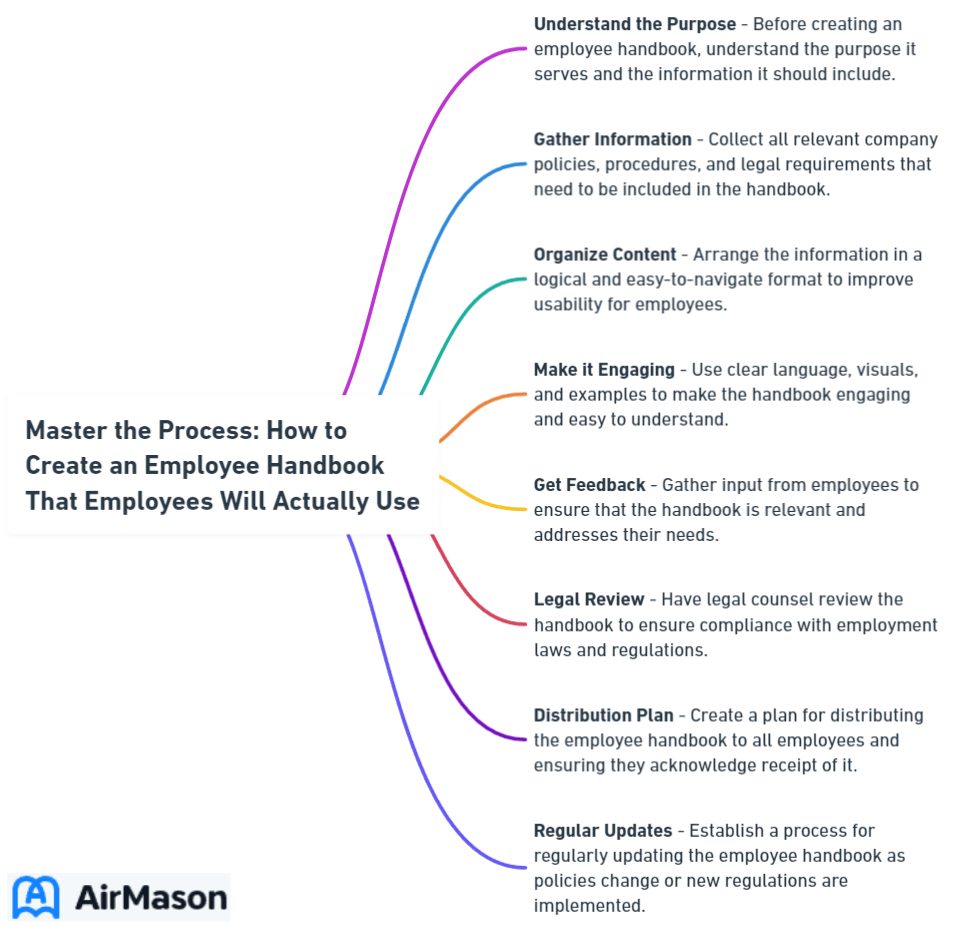
Need to create an employee handbook that guides and supports your team effectively? This article cuts straight to the chase on how to compile a handbook that’s practical, compliant, and culture-oriented, with a focus on implementing policies that employees will reference and adhere to. Expect to find the essential ingredients for a handbook your staff will use as a daily resource.
Key Takeaways
- A comprehensive employee handbook is essential in reducing workplace confusion, aligning with legal requirements, and reflecting company culture; it should cover everything from employment guidelines to compensation and development opportunities.
- Maintaining an employee handbook requires regular updates, proactive communication of changes, and solicitation of employee feedback to ensure the content remains relevant, legally compliant, and in sync with employee needs and company evolution.
- To be effective and engaging, an employee handbook should use an accessible, interactive format with multimedia elements, and consider inclusivity for remote workers and those with disabilities, as well as continuous leadership involvement.
Employee Handbook Benefits
Employee handbook benefits encompass a wide array of advantages for both the employees and the organization. These benefits serve as a crucial tool for communicating policies, procedures, and expectations to employees, fostering a transparent and consistent work environment. Through the employee handbook, employees gain insights into their rights, responsibilities, and available resources within the company. Furthermore, a well-crafted handbook can contribute to enhanced employee satisfaction and morale by providing clarity on various aspects such as benefits packages, leave policies, and code of conduct. Moreover, it serves as a reference point for resolving disputes or addressing disciplinary actions, promoting fairness and accountability across the organization. Overall, investing in a comprehensive employee handbook not only streamlines operations but also nurtures a positive company culture built on trust and mutual understanding.

The Importance of an Employee Handbook
An employee handbook is more than a document gathering dust at the corner of an office desk; it’s a powerful tool that mitigates workplace confusion and fosters a positive work environment. A well-crafted own employee handbook clearly outlines employee responsibilities, ensuring company policies are followed.
The handbook, a conduit for communicating key company policies, plays a vital role in:
- Eliminating confusion and fostering consistency in policy application
- Educating staff on what to expect from management and leadership
- Promoting healthy working relationships
- Clarifying logistical operations.
This comprehensive manual not only aids in defending against employee claims but also provides employees with information on where to turn for help within the organization, reducing the likelihood of external complaints.
Crafting a Comprehensive Employee Handbook

While the task of creating an employee handbook may appear daunting at first, it need not be so. Keeping in mind your company’s unique culture and legal requirements, you can craft a comprehensive and effective handbook that becomes an essential resource for your employees.
Company Overview and Culture
Kickstart your employee manual with an introduction to your company’s background, mission, vision, and company values. This gives new hires a glimpse of the organization’s story and values, making them feel at home within the organizational culture.
Steer clear of the common mistake of excluding your company’s values and culture from the handbook. This can result in a missed opportunity to inspire employees and perpetuate a fulfilling work environment. Remember, your handbook is a reflection of your company’s identity; make it count.
Employment Guidelines
Outlining employment guidelines in your employee handbook lays the foundation for a transparent and fair work environment. To get inspired, you can refer to some employee handbook examples. The employee handbook outlines vital information such as arrival and departure times, procedures for reporting absences, and time-off requests to aid in attendance management.
A detailed code of conduct, also known as company rules:
- Sets clear expectations for how employees should interact with colleagues, partners, and customers
- Provides a legal framework for addressing misconduct
- Informs employees of the risks of policy violations
- Ensures fair treatment through clearly stated disciplinary policies.
Workplace Policies and Procedures
The journey to a safe and inclusive workplace starts with the delineation of clear policies against discrimination and harassment. Incorporating anti-discrimination training in your handbook is integral for maintaining a fair and diverse workplace.
In addition, a detailed harassment prevention policy, complete with reporting and investigation procedures, actively combats workplace harassment. Don’t neglect policies that enhance diversity and inclusion, as they are critical to creating an environment where all employees feel safe and valued.
Compensation, Benefits, and Development
The central motivators for employees often include compensation, benefits, and opportunities for development. Clear information about work hours, compensation, and benefits is key to addressing employees’ primary concerns and ensuring awareness of policies.
Detail important employee benefits such as vacation, 401(k), health insurance, and others in your handbook to keep employees informed. Outlining professional development paths and recognition programs can motivate employees by setting clear performance expectations and showing the company’s investment in their growth, employee behavior, and employee engagement.
Legal Compliance and Disclaimers
Legal compliance is a crucial aspect of crafting an employee handbook. Your handbook should adhere to all applicable laws, including local, state, federal, or international laws, such as data privacy and anti-discrimination laws.
To ensure compliance, regularly check the handbook against federal laws and regulations, consulting with legal experts as necessary. Include employment at-will disclaimers to clarify the employment relationship and mitigate potential legal disputes. Remember, a legally sound handbook not only protects the company but also the rights of your employees.
Designing an Engaging Employee Handbook

Beyond being a mere compendium of rules and regulations, your employee handbook should serve as a captivating resource for your employees. Make your handbook skimmable with:
- plenty of headings
- subheadings
- bullet points
- a clear table of contents
Take advantage of digital platforms to incorporate interactive visuals like:
- quizzes
- summary sections
- clickable links
- videos
- infographics
Also, ensure your handbook is mobile-friendly to support on-the-go access for your employees. Remember, an engaging handbook is a used handbook.
Allied Universal Employee Handbook
The Allied Universal Employee Handbook serves as a comprehensive guide for employees, outlining company policies, procedures, and expectations. From workplace conduct to benefits and safety protocols, the handbook provides essential information to ensure a productive and harmonious work environment. Employees are encouraged to familiarize themselves with the contents of the Allied Universal Employee Handbook to uphold company standards and contribute to the overall success of the organization.
Maintaining and Updating Your Employee Handbook

The employee handbook isn’t a document you create once and forget about. To keep it relevant and legally compliant, you must regularly review and update its content, engage in a constant dialogue with your employees, and effectively communicate any updates.
Soliciting Employee Feedback
Given that your employees are the main users of the handbook, their feedback plays an indispensable role. Encourage employee feedback on the handbook to improve its content and relevance.
To gather comprehensive feedback, use surveys, focus groups, and feedback committees. This not only helps in improving the handbook but also makes employees feel valued and heard. Remember, an effective handbook is a collaborative effort.
Communicating Changes to Employees
Upon updating your handbook, it’s crucial to keep your employees well-informed about the modifications made. It’s important to keep them in the loop about any new policies or procedures. Use various channels such as:
- meetings
- emails
- internal newsletters
- internal communication platforms
To inform new employees of updates.
Not only should you communicate the changes, but it’s also crucial to provide training on new policies to ensure understanding and compliance. Remember, a handbook is only effective if its policies are understood and followed.
Common Mistakes to Avoid in Employee Handbooks
Crafting an effective employee handbook can be a delicate balancing act. A common pitfall that you should steer clear of is the sole reliance on employee handbook template. While templates can be a good starting point, they often lack the personal touch that reflects the company’s unique culture and procedures.
Another pitfall is having unclear policies, particularly in areas such as benefits and time-off accruals. Clear, unambiguous policies can reduce confusion and maintain legal compliance.
Finally, involve leadership in the development of the handbook and establish a review process to keep it updated and aligned with the company’s current practices and values.
Digital Accessibility and Remote Work Considerations
In the digital era we live in, the accessibility of your handbook to all employees, including those with disabilities, bears great importance. Digital handbooks offer multimedia features to enhance understanding and include functionalities like hyperlinks and search tools for easy navigation.
Moreover, with the rise of remote work, it’s crucial to include remote work policies in your handbook, while using inclusive and non-discriminatory language to accommodate a diverse workforce. After all, an inclusive handbook is a successful handbook.
Examples of Successful Employee Handbooks

Looking for inspiration? Consider the innovative handbooks of companies like Valve Corporation, Netflix, and Whole Foods Market. Valve Corporation, for example, provides guidance on navigating the company’s unique flat organizational structure in their handbook.
Netflix’s Culture Deck, on the other hand, outlines the company’s culture of freedom and responsibility, which is an integral part of their company’s culture. Meanwhile, Whole Foods Market’s employee handbook, known as the “Declaration of Interdependence,” showcases their commitment to sustainability and healthy living. These examples illustrate that an employee handbook can be more than just a set of rules, but a reflection of a company’s identity and values.
Summary
Creating an effective employee handbook is a strategic process that requires thoughtful consideration, regular updates, and ongoing engagement with your employees. By keeping your handbook clear, comprehensive, and engaging, you’ll create a resource that not only guides your employees but also builds a strong company culture.
Employee Handbook Template Word Free
Are you searching for a comprehensive and user-friendly employee handbook template that is available for free in Microsoft Word format? Look no further! Our employee handbook template word free is designed to provide all the essential policies, procedures, and guidelines that your employees need to know. With easy-to-edit sections and customizable content, you can tailor the handbook to fit your organization’s specific needs and requirements. Download our free employee handbook template in Word format today and streamline your onboarding process while ensuring compliance and clarity for your employees.
Frequently Asked Questions
How do I create an employee handbook?
To create an employee handbook, start by reviewing and revising the current company policies, then create an outline and summarized versions of each policy and procedure. It’s also important to include company values, workplace policies, code of conduct, compensation, benefits, and a disclaimer. Finally, gather feedback to ensure the handbook is effective.
How do I make a handbook template?
To make a handbook template, create an outline, summarize key points of policies, decide on a tone, use a professional document creator, utilize a ready-made template, get legal review, and publish the handbook.
What is legally required in an employee handbook?
Legally, an employee handbook should cover topics such as minimum wage, overtime regulations, anti-discrimination policies, and family and medical leave. It should also include the employer’s mission statement, equal employment opportunity statement, and purpose of the handbook.
What is the best software to create employee handbooks?
The best software to create employee handbooks is Handbooks.io, which enables organizations to create HR-approved company manuals quickly and easily. It offers templates ready to use in all 50 US states.
Why is it important to have an employee handbook?
Having an employee handbook is important because it effectively communicates company policies, employee rights, and expectations, fostering a healthy work environment while reducing the likelihood of disputes.
Important Disclaimer:
Please be aware that the content on this page has been generated by using artificial intelligence language models and may contain errors, inconsistencies, or outdated information. It is provided as-is without any warranties or guarantees of accuracy.
We strongly recommend using this content as a starting point for further research. We disclaim any liability for damages or losses resulting from the use or reliance on this content.